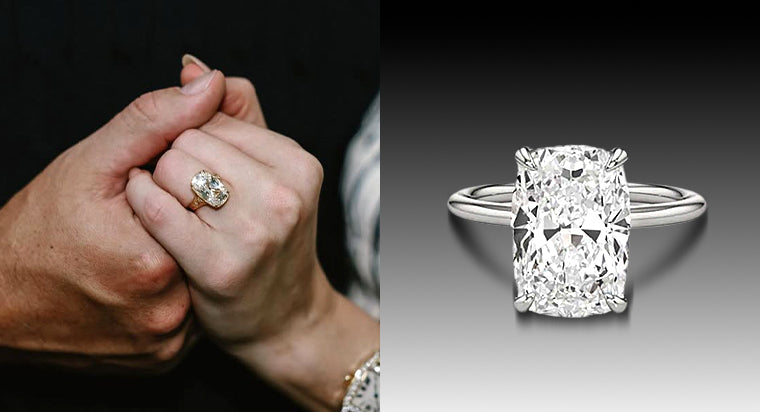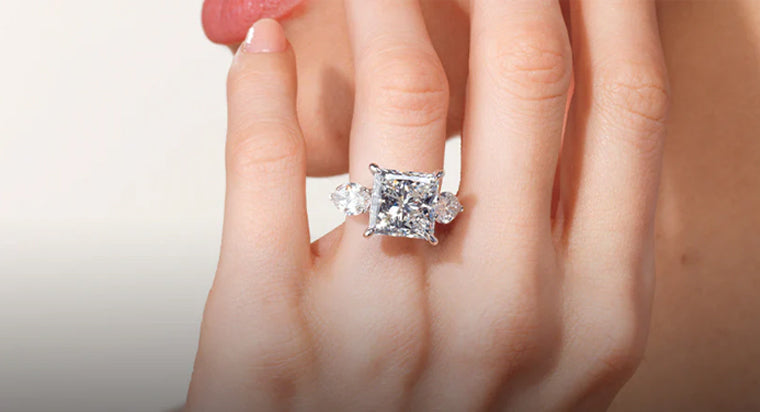Caring For Lab Grown Diamond Engagement Rings - The Do's and Don'ts

More and more couples are purchasing lab grown diamond engagement rings, and they continue to grow in popularity. People are drawn to lab diamonds because they're an environmentally friendly, ethically sourced alternative to mined diamonds.
Although lab diamonds are durable, hard, and last for many years, it's essential to care for them properly. In this article about, "Caring For Lab Grown Diamond Engagement Rings - The Do's and Don'ts," we'll explore the essential guidelines for maintaining the beauty and longevity of these stunning gemstones.
TABLE OF CONTENTS
Understanding Lab Grown Diamonds
The process of creating a lab grown diamond is similar to the process of creating natural diamonds - the only difference is one occurs within the Earth's crust, and the other is made in a laboratory. When creating a lab grown diamond, the manufacturing process replicates conditions that create natural diamonds - extreme temperatures and pressures that turn carbon into a diamond. However, the processes occur in a controlled environment in a lab.
Manufacturers have two ways to create lab grown diamonds - High-Pressure High Temperature (HPHT) and Chemical Deposition (CVD):
- HPHT: A diamond "seed" is added to carbon. The seed is a small natural diamond fragment that can undergo extreme temperature and pressure conditions. The HPHT diamond growth process subjects diamond seed and carbon to extreme temperatures (in excess of 1,300-1,600 degrees Celsius) and pressures (one million pounds per square inch) to replicate the intense heat and pressure environments found deep within the Earth where natural diamonds are created. The carbon forms around the diamond seed and is then cooled.
- CVD: The chemical vapor deposition system also begins with a diamond "seed." It's crucial to select the strongest and highest grade (in color and clarity) natural diamond bit. During the CVD process, the vacuum chamber in which the diamond seed is placed fills with gasses that are heavy in carbon and is then heated to well over 1,000 degrees. The intense heat then turns the gasses into "plasma." The plasma is what helps "build" the layers of the diamonds.
The care for lab grown and natural diamonds is the same because they have the same chemical composition, optical properties, and physical features. No matter what type of diamond you have, care and maintenance are important.
The Do's of Caring for Lab Grown Diamond Engagement Rings
- Regular Cleaning: Dirt and grime can get embedded within the setting and hide around the prongs. It's essential to clean your diamonds routinely to get rid of that built-up grime. Soak your ring for around 15 minutes in a bowl of warm water and mild soap. Use a softly bristled brush to gently remove stuck-on dirt and get your diamond sparkling once again.
- Inspections: Yearly inspections by a professional jeweler will help ensure your stone is secure and safe in your setting, and they'll closely look at the rest of the setting as well. They'll focus on the prongs to ensure they haven't worn down too much.
- Proper Storage: Diamonds are hard enough to scratch other jewelry. To protect your engagement ring and your other jewelry pieces, store the ring in a soft cloth or put it in a lined jewelry box when you're not wearing it.
- Safe Usage: Rings are conformable. You'll probably forget that it's on sometimes, but it's best to remove it before engaging in physical activities that could damage the diamond or the setting.
- Insurance: Insurance protects your investments, and your diamond engagement ring is a valuable and sentimental piece of property.
The Don'ts of Caring for Lab Grown Diamond Engagement Rings
- Avoid Harsh Chemicals: Avoid wearing your rings when you're cleaning or swimming because of the harsh chemicals. They can damage the diamond and the metal setting.
- Limit Ultrasonic Cleaners: Don't use ultrasonic cleaners frequently. If the mined or lab grown diamonds have many inclusions, the ultrasonic waves can affect them. So it is best to avoid.
- Beware of Sudden Temperature Changes: Thermal shock occurs when extreme heat is applied to a diamond. When susceptible to sudden and drastic temperature changes, the gemstone can crack or fracture.
- No DIY Repairs: Don't attempt any DIY repairs to your jewelry. Always seek help from a professional jeweler.
Ethical Considerations
Purchasing a lab grown diamond means you aren't supporting conflict diamonds. Lab grown diamonds are conflict-free, and you can pinpoint exactly where they were made. Conflict diamonds (also called "blood" diamonds) are gemstones mined in war zones in order to perpetuate war or fund warlords and insurgents.
Lab grown diamonds are also more environmentally friendly. Mining diamonds from the Earth takes plenty of fossil fuel resources and destroys land, ecosystems, and wildlife. Using fossil fuels also releases carbon and other greenhouse gases into the atmosphere. It requires energy to run the diamond mining facilities as well. While lab diamonds require some resources, they're less than the damage from natural mining operations.
At With Clarity we have a gamut of lab grown diamonds in various designs, cut and clarity for you to choose from without burning a hole in your pocket. Browse from our range of lab grown diamond engagement rings and find your ideal match.
Conclusion
More couples are seeking out lab grown diamond engagement rings because their ethical and environmentally friendly aspects align with their personal values. Laboratories create lab grown diamonds by using High-Pressure High Temperature (HPHT) or Chemical Deposition (CVD). Clean your ring periodically, have it inspected professionally, remove it before exercising, store your ring carefully, and insure it. Also, avoid harsh chemicals, sudden temperatures, frequent ultrasonic cleaning, and DIY repairs. Professional jewelers are an excellent resource, and the experts at With Clarity can answer any questions you have about caring for jewelry - especially lab grown diamonds. Follow these do's and don'ts to ensure that your diamond will remain sparkling for years to come.









